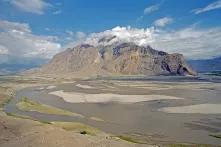In nuclear-armed Pakistan, everyday cities plunge into darkness and factories grind to a halt for several hours as the electricity goes out. Some Pakistanis look towards importing nuclear reactors as a solution.
Pakistan’s Energy Future: What Role for Chinese Nuclear Reactors?
By Pervez Hoodbhoy
In nuclear-armed Pakistan every day cities plunge into darkness and factories grind to a halt for several hours as the electricity goes out. While emergency generators automatically turn on to light the homes of the rich, for ordinary Pakistanis the summer heat becomes unbearable as fans stop beating the turgid air. Angry mobs have attacked electricity company offices, set transformers ablaze, and beaten up government officials. Some Pakistanis look towards importing nuclear reactors as a solution.
It seems odd at first sight to understand why Pakistan, a country that can make nuclear weapons and ballistic missiles, and has an Atomic Energy Commission that employs over 30,000 people, has electricity blackouts. Pakistani authorities blame Western countries for denying it nuclear energy because it will not sign the nuclear non-proliferation treaty (NPT). The NPT expressly forbids transfer of any kind of nuclear technology, including that for power generation, to non-signatories.
But the fact is that despite a 50-year long nuclear history, and vast spending, Pakistan has proven unable to build for itself even a single nuclear reactor to make more electricity. It relies on a forty year old Canadian reactor (in Karachi) and a ten year old Chinese reactor at Chashma, which together constitute 2% of total electricity capacity. A second Chinese reactor has been under construction at Chashma since 2005 and is expected to be completed next year.
In February 2010, China agreed to Pakistan’s request to build two additional civilian nuclear reactors in Pakistan, each of 330 MW (about one-third the size of most modern nuclear power plants). To make this affordable China has offered to provide over 80 percent of the total $1.9 billion cost as a 20-year loan. The problem for Pakistan is that in 2004 China joined the 46 nation Nuclear Suppliers Group (NSG), whose rules prohibit supply of nuclear materials to non-NPT states.
China has not yet formally notified the NSG of its intention to supply the new reactors. It explained away the supply of the Chashma-II reactor under a so-called “grand-fathering clause”, arguing that an agreement had existed prior to its joining the NSG. The argument will not work for the proposed two new reactors. The issue will come to head in the next NSG meeting, to be held this week in Christchurch, New Zealand.
Western governments are unlikely to be thrilled. The US had registered only a muted objection. The US had arm-twisted the NSG in 2008 into agreeing to make special exemption from its rules for India, and has no credible counter-argument to protest a similar deal initiated by China. Moreover, serious efforts to block the sale would deeply irritate Pakistan, upon which the US relies for helping it fight the Afghan war. Thus political exigencies and economic interests have quietly put to death earlier restrictions placed upon global nuclear trade.
China’s interest in pushing the deal with Pakistan is fairly clear. The sale of two rather small-sized reactors to Pakistan is but a step in a larger plan to become a major producer and exporter of nuclear power plants. Pakistan is simply a test bed.
The impact of the Chinese reactors upon Pakistan’s energy crisis will be marginal. It will take 6-8 years after the contracts are formally signed before the electricity reaches the grid, if all goes to plan. Even then, the new reactors will contribute barely a drop in the ocean.
Pakistan’s problem is not primarily that of installed capacity. If all current sources are included, this amounts to a respectable 19,000 MW. In principle this should be more than adequate for Pakistan’s power demand, which stands at around 14,500MW. The problem is that a mere 10,200 MW is actually generated. About 30% of current capacity is not used. Government incompetence and mismanagement are to blame.
“Circular debt” – meaning the non-payment of electricity bills by the military and various government departments to other government departments – has had the effect of electricity producers being unable to import fuel oil. Thus, expensive imported plants stand idle.
An inefficient distribution system wastes over 10% of the electricity as it travels along transmission lines, through transformers, and in bad connections. This is compounded by an electricity grid that is unable to effectively distribute electricity from power plants to consumers.
Electricity theft, by rich and poor alike, is another critical factor. For a small bribe, electric company employees create unmonitored bypasses called “kundas” or tamper with meters. Electricity producers and distributors lose revenue. Stopping power theft would save far more megawatts than will be generated by Chashma’s four nuclear reactors, whenever they come on line.
Finally, Pakistani factories, offices and homes use machinery and appliances that are tremendously wasteful of energy. They do much less work with the electricity that is available. A serious energy efficiency and conservation program would be quick to implement and could avoid the need to build many additional power plants.
For new electricity generation capacity, Pakistan should use the vast deposits of Thar coal using appropriate technology to minimize the negative environmental consequences. Or it can build gas-fired power plants and fuel them using natural gas imported from Iran, its neighbor to the west. The only thing standing in the way is the United States’ determination to impose sanctions on Iran’s oil and gas industry. Time will tell if confronting Iran is to seen as more important than securing Pakistan’s energy future and preserving an international system on control over nuclear trade.
The author teaches physics at Quaid-e-Azam University in Islamabad


